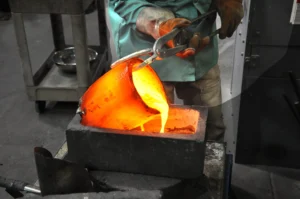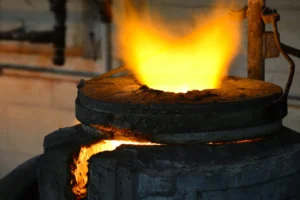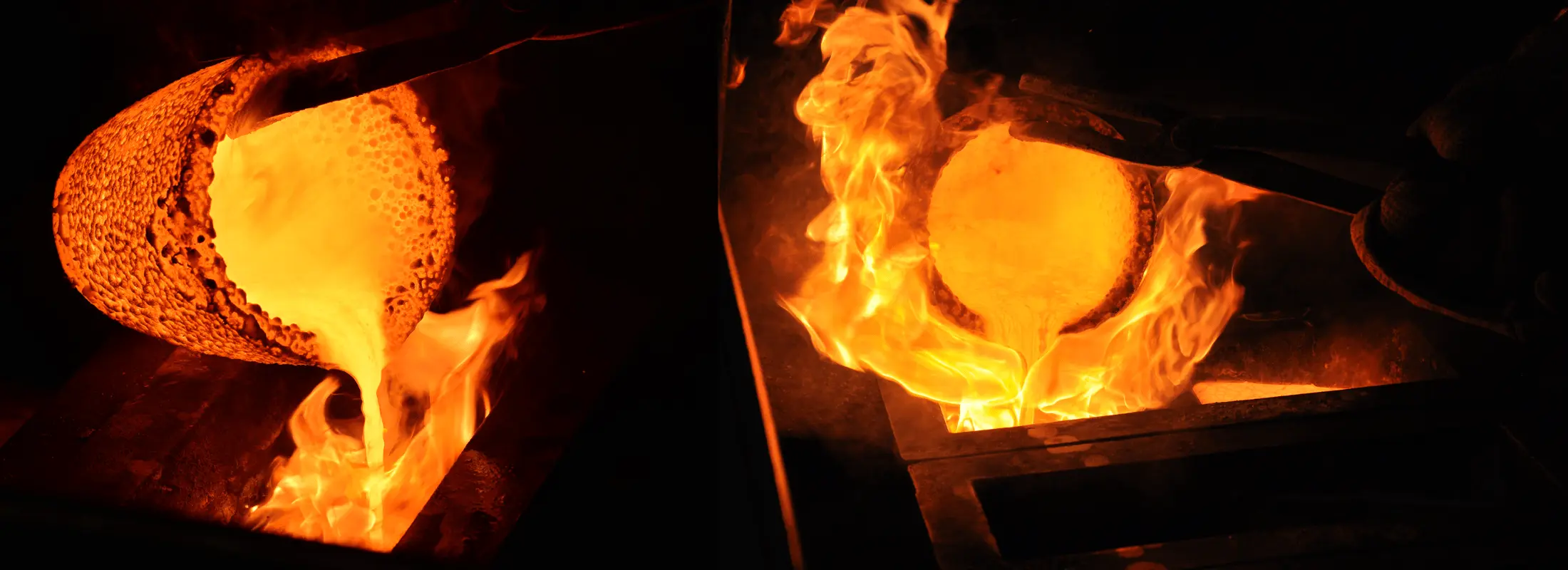
It’s been a scorching hot summer here at Garfield Refining’s headquarters in Philadelphia. We’re already in the midst of our third heat wave this year, and it might be the hottest one yet. Temps reached 100°F this week, which hasn’t happened since July of 2012 – 12 summers ago! Our melters in the refinery are always feeling the heat, but this week has been especially sweltering. They’re doing their best to stay cool and hydrated with tons of water, electrolyte packets and popsicles galore. (And when we’re running low on popsicles, we like to call in the Mr. Softee truck for backup.)
Here at Garfield, we melt precious metals every day. The melting point of gold is something we tend to take for granted. But with the excessive heat lately, we feel like we’re reaching our own melting point, and it’s gotten us thinking about the melting points of different metals.
A metal’s melting point plays a significant role in how it’s used (and for our purposes, how much energy it takes to refine). Have you ever wondered about the melting point of gold and how it compares to other precious metals like silver, platinum and palladium?
While all pure metals have a specific melting point, the melting points of metals that are alloyed (chemically combined with other metals) can vary.
What’s the Melting Point of Gold?
The melting point of gold is 1,948°F – more than ten times hotter than the boiling point of water!
Gold’s melting point is relatively high compared to many other metals, though it is not among the very highest. While gold melts at higher temperature than common metals like aluminum, zinc, lead and tin, it takes more heat to melt other metals like nickel, iron, platinum, palladium and tungsten. Tungsten has the highest melting point of all metals, at a whopping 6,192°F!
Gold’s melting point makes it a rewarding material to work with – it’s challenging, but worth it. Goldsmiths and jewelers employ special tools and techniques in order to melt and shape their gold. Gold’s ability to maintain its structure and integrity under high temperatures is indicative of its overall stability as an element, which plays a huge role in its durability. Gold is exceptionally resistant to tarnish and corrosion. When gold is alloyed with other metals, the resulting material is durable enough to create jewelry that will last a lifetime.
Gold’s melting point also makes it ideal for recycling, which is what we do here at Garfield. Gold can be melted down and reused continuously without losing its quality, making it a sustainable material for a wide range of applications.

At What Temperature Does Pure 24k Gold Melt?
While pure 24k gold melts at 1,948°F, the melting point of gold alloyed with other metals will vary. Gold is often alloyed with silver, copper and/or zinc to increase durability when making items like jewelry. Typically, gold that is less pure will have a lower melting point. For example, a piece of 18k jewelry will likely have a melting point of around 1,700°F, as compared to the 1,948°F melting point of pure gold.
What About Other Precious Metals?
Silver has a lower melting point than gold, while platinum and palladium have higher melting points than gold.
At 1,763°F, silver’s relatively lower melting point makes it a bit easier to work with than gold or platinum. It’s a great choice for beginner metalsmiths looking to create jewelry, flatware or other decorative items. Molten silver flows smoothly into molds and can be worked into intricate shapes and forms. Silver also has high thermal conductivity, allowing it to distribute heat quickly and evenly, which is helpful when heating and cooling the metal during jewelry making.
Platinum and Palladium
Platinum has the highest melting point of the major precious metals at 3,216°F. This makes platinum especially suited to applications like spark plugs, electrodes and components of aircraft and vehicles.
And although it’s not as easy to work with as silver or gold, platinum is still prized in the jewelry industry for its exceptional shine and durability. It takes more time, energy and special equipment to melt and shape platinum, but that hasn’t stopped jewelers from using it – as you may know, it’s a very popular choice for engagement bands and wedding rings!
Palladium has a melting point of 2,831°F – a bit lower than platinum, but higher than silver and gold. Similarly to platinum, palladium holds strong at super high temperatures, making it useful in electronics, dentistry, automotive parts and various industrial applications.

How Much Gold Is Lost When Melted?
If you’re melting pure gold with the proper techniques and equipment, little to none of it should be lost. There are several factors that can lead to some loss of gold during the melting process, but they are preventable for the most part.
For example, tiny particles of gold can be lost when transferring molten gold from a crucible to a mold, or small amounts can be splattered or spilled during the melting process. (These are the exact things we’ve mastered the art of avoiding at Garfield!)
If a significant amount of gold is lost during the melting process, it likely wasn’t pure to begin with. Impurities are the main cause of gold melt loss. For example, when melting gold jewelry that contains steel wires or trace amounts of silver or zinc, those elements will be melted off along the way, resulting in a lower post-melt weight. Similarly, if you’re melting dental gold, there may be some organic material attached to the gold before it’s melted away.
Melting is Our Specialty
At Garfield Refining, we specialize in getting maximum yields when melting down precious metals to be recycled. We refine gold, silver, platinum and palladium, accepting all four metals in as-is condition. We serve various industries including jewelers, pawn shops, dentists, private individuals and more. We take pride in recycling valuable metals and getting our clients the highest possible payouts! If you have unwanted precious metals that you’re looking to refine, leave the melting to us. We excel in refining your metals as efficiently as possible, so you can get paid fairly and promptly.
Stay tuned to our blog for more tidbits on precious metals! If you enjoyed this post, check out other interesting articles like ‘How Well Can Metal Detectors Detect Gold?’ and ‘Where is Palladium Scrap Found?’
Are you looking to sell your unwanted precious metals or invest in bullion? Look no further than Garfield Refining! Established in 1892, we have more than a century of experience in refining precious metals. Download a free label to start your shipment today, or browse through our bullion selection!

